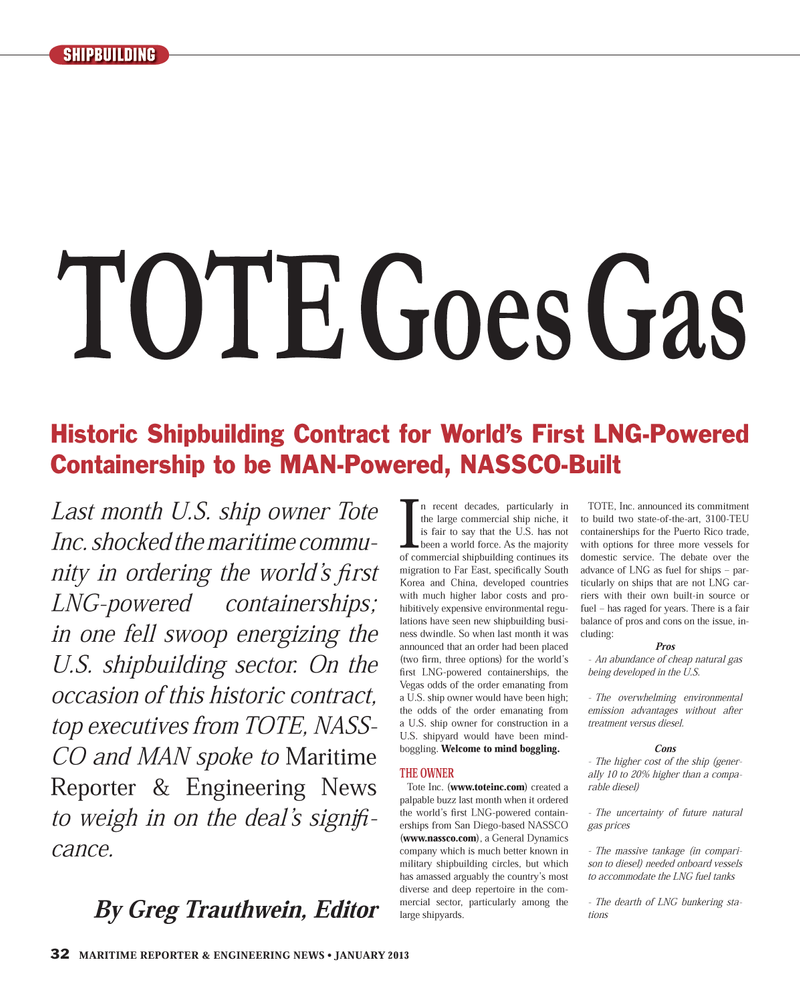
Page 32: of Maritime Reporter Magazine (January 2013)
Ship Repair & Conversion
Read this page in Pdf, Flash or Html5 edition of January 2013 Maritime Reporter Magazine
32 MARITIME REPORTER & ENGINEERING NEWS ? JANUARY 2013 SHIPBUILDINGTOTE Goes Gas Historic Shipbuilding Contract for World?s First LNG-Powered Containership to be MAN-Powered, NASSCO-Built In recent decades, particularly in the large commercial ship niche, it is fair to say that the U.S. has not been a world force. As the majority of commercial shipbuilding continues its migration to Far East, speciÞ cally South Korea and China, developed countries with much higher labor costs and pro-hibitively expensive environmental regu-lations have seen new shipbuilding busi-ness dwindle. So when last month it was announced that an order had been placed (two Þ rm, three options) for the world?s Þ rst LNG-powered containerships, the Vegas odds of the order emanating from a U.S. ship owner would have been high; the odds of the order emanating from a U.S. ship owner for construction in a U.S. shipyard would have been mind-boggling. Welcome to mind boggling. THE OWNERTote Inc. ( www.toteinc.com ) created a palpable buzz last month when it ordered the world?s Þ rst LNG-powered contain- erships from San Diego-based NASSCO (www.nassco.com ), a General Dynamics company which is much better known in military shipbuilding circles, but which has amassed arguably the country?s most diverse and deep repertoire in the com-mercial sector, particularly among the large shipyards. TOTE, Inc. announced its commitment to build two state-of-the-art, 3100-TEU containerships for the Puerto Rico trade, with options for three more vessels for domestic service. The debate over the advance of LNG as fuel for ships ? par- ticularly on ships that are not LNG car- riers with their own built-in source or fuel ? has raged for years. There is a fair balance of pros and cons on the issue, in-cluding:Pros- An abundance of cheap natural gas being developed in the U.S.- The overwhelming environmental emission advantages without after treatment versus diesel. Cons- The higher cost of the ship (gener- ally 10 to 20% higher than a compa-rable diesel)- The uncertainty of future natural gas prices- The massive tankage (in compari- son to diesel) needed onboard vessels to accommodate the LNG fuel tanks- The dearth of LNG bunkering sta- tionsLast month U.S. ship owner Tote Inc. shocked the maritime commu-nity in ordering the world?s Þ rst LNG-powered containerships; in one fell swoop energizing the U.S. shipbuilding sector. On the occasion of this historic contract, top executives from TOTE, NASS- CO and MAN spoke to Maritime Reporter & Engineering Newsto weigh in on the deal?s signi Þ -cance.By Greg Trauthwein, Editor MR #1 (26-33).indd 32MR #1 (26-33).indd 321/2/2013 11:51:06 AM1/2/2013 11:51:06 AM

 31
31

 33
33
